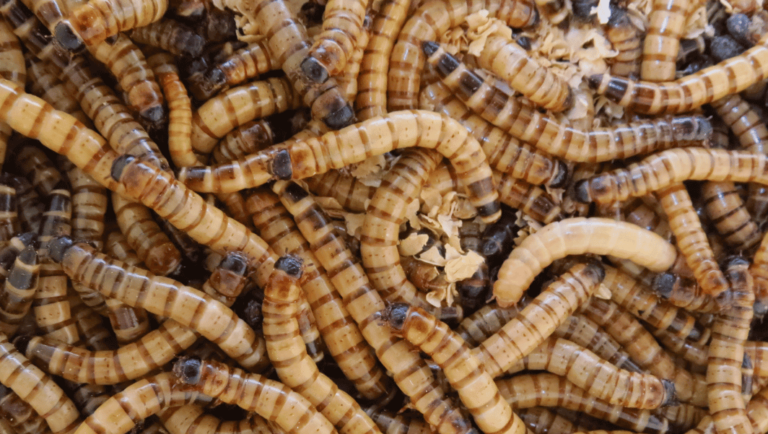As a long-time enthusiast of leopard geckos, I’ve always been fascinated by their dietary preferences and needs. Many owners, including myself, have pondered whether leopard geckos can safely consume superworms. Known scientifically as Zophobas Morio, these larvae of the darkling beetle are considered a superior food source not only for reptiles but also for fish, birds, and rodents. However, their high-fat content necessitates caution. While superworms serve as an excellent dietary supplement due to their high protein and fat content, they should be regarded more as a rare treat rather than a staple.
As a snack, superworms offer variety to your leopard gecko’s diet, but it’s crucial to offer these particular worms in moderation. Overfeeding can lead to obesity and related health issues in leopard geckos. Therefore, it’s advisable to discover a balance and treat these super worms as an occasional delight. This approach ensures the health and well-being of your beloved pet while allowing them to enjoy these treats without adverse effects.
Table of Contents
What Are Superworms?
Superworms, commonly mistaken for actual worms, are the larvae of the darkling beetle, scientifically known as Zoophobas morio. Native to Central and South America, these large, cylindrical, brown-orange larvae are known as king worms or morio worms. For decades, they have been bred in captivity as a quality live food source for reptiles, birds, fish, and other animals. Intriguingly, recent studies have explored superworms as an alternative source of protein for both cattle and potentially humans, highlighting their ability to live off and digest materials like plastic waste, including polystyrene. Their capacity to bite through thin plastic boxes, commonly used for purchase, contrasts with their emerging role as agents in waste processing, underscoring their environmental importance.
How Nutritious Are Superworms?
Considering where we get superworms, their nutritional content can significantly change the nutrition of a leopard gecko’s upbringing. Several factors influence their nutritional makeup. It’s important to Make sure the snacks you buy for your gecko come from reputable merchants to ensure your geckos have a consistent, free, and secure supply of wholesome food. Some leopard gecko pet owners even cultivate their source of meal.
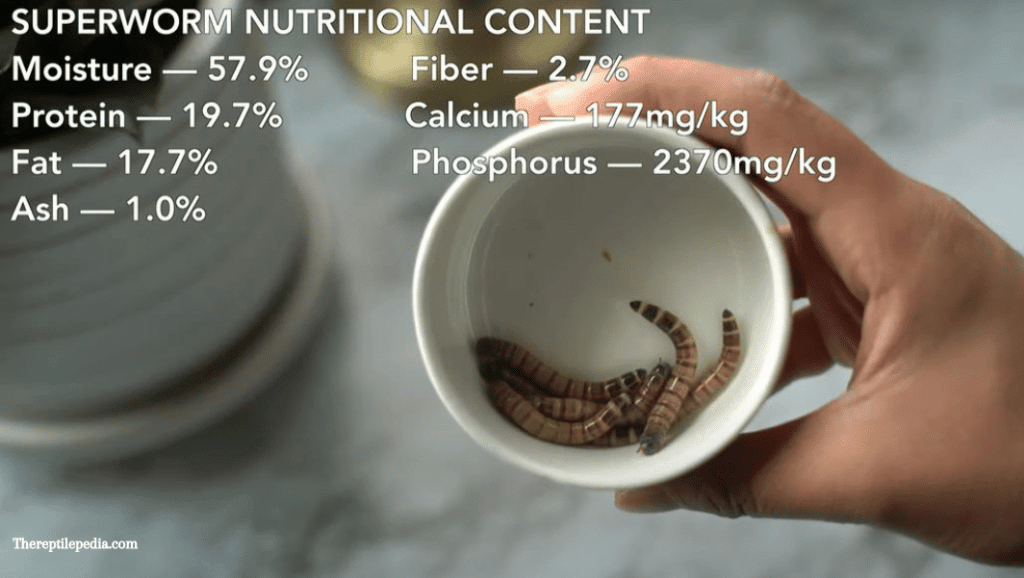
In terms of specifics, superworms contain about 57.9% humidity, 19.7% protein, 17.7% fat, 2.7% fiber, 177 mg/kg calcium, and 2370 mg/kg phosphorus. These figures place them at about fifth in terms of superworms’ bodies being primarily fat. This means a leopard gecko can increase in phosphorus if consumed in excess. Moderation is key to not overwhelm their intake of calcium and to promote good health, avoiding risks like metabolic bone disease.
Leopard geckos often enjoy the taste of these bugs, which is one reason why animal specialists consistently suggest cutting back on the reptile diet. Superworms should be an uncommon sight in their diet; it’s not uncommon to see a gecko devour them immediately. However, being overfed with them can result in obesity.
Can leopard geckos eat Superworms
While Superworms can be a great food choice for leos (leopard geckos), they shouldn’t become regular items in your gecko’s diet. However, they are far from perfect. One significant concern with superworms is their poor calcium-to-phosphorus ratio, a characteristic common to many feeder insects. This imbalance can lead to specific issues in leopard geckos, particularly affecting their bone health. As a responsible pet owner, it’s crucial to understand these dietary nuances to maintain the health and well-being of your leopard gecko.
Do Superworms Turn Into Beetles?
Superworms are fascinating creatures that do indeed change from their larval form into pupa and then develop into darkling beetles. An intriguing aspect of their life is that they can be cannibalistic, meaning if left in a group, they might consume each other. This behavior is especially noticeable during their transformation phase. Once they develop into beetles, they are capable of reproducing and laying eggs, which then hatch and restart the cycle. Managing this cycle can be one of the more challenging aspects of raising them, particularly for those breeding superworms as a food source for pets.
Superworms Life Cycle
In the Superworm life cycle, there are four stages: Egg, Larva, Pupa, and Adult. These fascinating creatures spend most of their life as larvae. Interestingly, if kept apart, the larvae will mature into beetles, but they won’t pupate in proximity to too many other larvae. This unique aspect of their life cycle requires careful management for those breeding them as a food source for leopard geckos or other reptiles. Understanding this cycle is essential to ensure a continuous and healthy supply of superworms for pet owners.
The Egg Stage
The initial stage of a super worm’s existence begins as an egg. These eggs are spent in a state that is often unnoticed due to their little, white, bean-shaped appearance, roughly the size of a dust particle. Their stickiness often leads them to be covered in dirt, dust, or debris. This camouflaging effect is a natural defense mechanism. The egg stage can last one to four weeks, after which the larva emerges, marking the beginning of a more active phase in the superworm’s life cycle. Understanding this stage is crucial for those breeding superworms as feed for leopard geckos, ensuring a healthy and sustainable cycle.
The Larva Stage
In the Superworm’s life cycle, their larvae stage, where they are known as darkling beetle grubs, is a period of significant growth and activity. During this time, the larvae, equipped with three pairs of legs and distinct mouthparts, engage in a never-ending search for food. They primarily consume a lot of organic matter like dead plants, leaves, and tree bark.
Throughout this stage, they repeatedly molt, sloughing off their outer coat as they grow. The lifespan of a superworm in this stage can last from six months to a year. Unlike some other larvae, superworms do not start to pupate unless they are separated from other super worms; their bodies undergo significant changes only when they are isolated, marking a unique aspect of their development.
The Pupa Stage
In the Superworm’s life cycle, the pupa stage is a time of transformation. During this phase, superworms curl inward, bringing their head close to their tail, and form silk cocoons around themselves which then harden into a protective shell, indicating they are ready to pupate. Unlike the active larva stage, Darkling beetle grubs in the wild often hibernate in the ground during this time, ceasing moving and eating.
This pupa is a resting phase where the tissue of the larva disintegrates inside the cocoon, as it rebuilds its organs and body into that of an adult beetle. This metamorphic process takes roughly 10 to 14 days, or about two weeks, for them to fully develop, after which they emerge as adult superworms.
The Adult Stage
Upon completing the pupal stage, a superworm emerges with fully grown antennae, legs, and wings, marking its transition into the adult phase. Now a darkling beetle, its reproductive system is fully developed, ready to take its spot in the world. As adults, they live mostly on the ground, keeping busy both day and night. Their diet remains mostly the same as in the larva stage. Superworms, in their adult beetle form, love dark, damp, and humid environments, often seeking out cold, moist spots when it’s hot outside. Remarkably, they can survive anywhere from 3 to 15 years as an adult, demonstrating their resilience and adaptability.
Are Superworms Safe for Leopard Geckos?
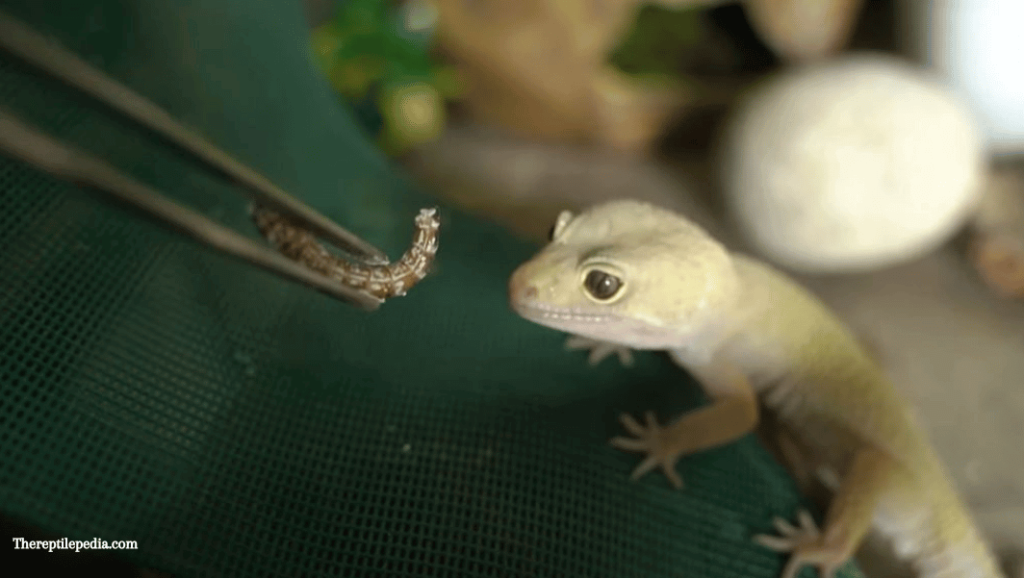
Feeding superworms to leopard geckos is not dangerous if done properly, but it’s essential to learn about the downsides of these feeders. Their high-fat content and large size can pose challenges. Although superworms are not the best for everyday food or a staple for leos, overconsumption can lead to too much weight gain and fatty liver disease. A full-size superworm might be too large for a leopard gecko to handle comfortably. Their thick, hard exoskeletons are hard to digest, and their extra-hard heads and large jaws, equipped with a defensive spike, can cause pain and, in rarer cases, damage to the gecko. This can sometimes lead to impaction.
To neutralize these potential dangers, it’s vital to have experience with super worms. They should be fed in moderation and perhaps only to adult geckos. Properly sizing the superworms to match the size of your gecko and ensuring they are not overfed can help prevent these issues and make superworms a safe and enriching addition to your leopard gecko’s diet.
ALSO READ: Can Leopard Geckos Eat Hornworms?
Can Superworms Bite Through a Gecko’s Stomach?
The urban legend that superworms can bite through a lizard’s stomach and chew their way out to freedom, leading one to wonder if they could kill your beloved pet, is precisely that – an urban legend, and luckily, not true. A Leo’s lacerating jaws, strong muscles, and burning stomach acid quickly disable any prey once swallowed. However, we can’t exclude the possibility that a super worm might give a nasty nip before being completely subdued, but usually, it’s not dangerous. A bite might be painful to the lizard, and in rare cases, it could lead to infection, but such incidents are exceptionally uncommon.
The Best Way to Feed Leopard Geckos Superworms
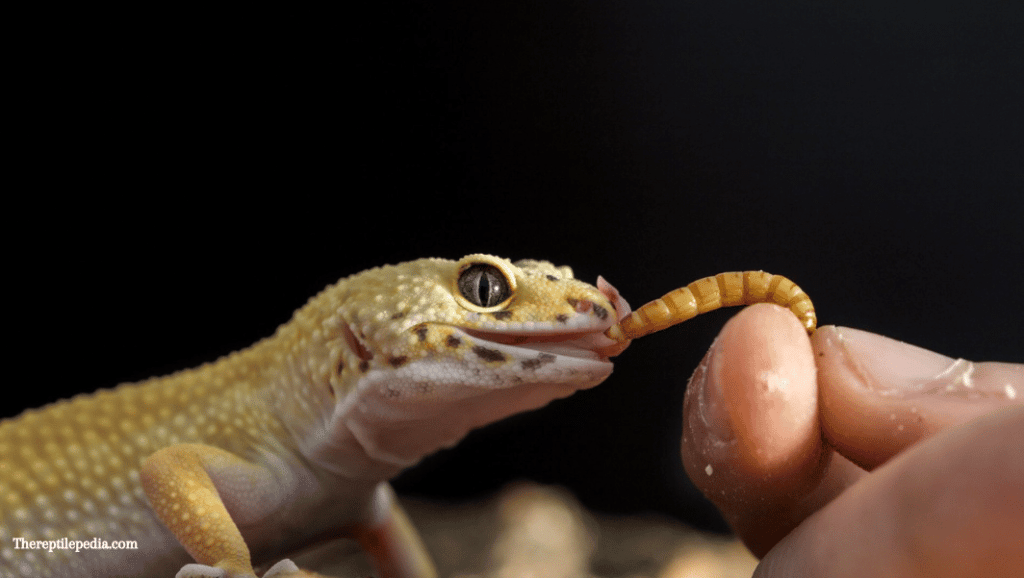
When deciding how to best feed super worms to a leopard gecko, consider the size of your pet. A smaller gecko should only consume 1 to 2 superworms per feeding, while a bigger leopard gecko might handle 3 to 4. The ideal size of the superworms should correspond to the size of the gecko. Set the worms in a container and put it inside the leopard gecko’s habitat, offering them either live or dead. If you live, be cautious not to offer too many at once to avoid the risk of the Superworms fighting and potentially hurting each other or the gecko.
Additionally, presenting lifeless super worms put on a plate or a paper towel in the habitat allows the gecko to consume a few at a time, eliminating the risk of the superworms perishing if not eaten immediately. For smaller geckos, feed 1 to 2, and for larger ones, 3 to 4 superworms is sufficient. Keep in mind that superworms are deficient in some nutrients necessary for your gecko’s health, so they should only be provided as a special treat and not the main component of their diet.
My Experience With Feeding Superworms to Leos
Reflecting on my journey with leopard geckos, I’ve observed some notable aspects of feeding Superworms to my leos. A few times, after eating an entire, large superworm, I noticed a distinct decrease in their mealtime enthusiasm. It took them a couple of days to bounce back, which indicated a change in appetite that was quite unsettling and certainly not to ignore. Additionally, once, I discovered a battered-looking, dead Superworm in the tank, which I suspect was possibly expelled by vomiting. These experiences have taught me the importance of monitoring their reactions to different foods and ensuring their dietary health is always a priority.
From my experience, feeding Superworms to leopard geckos can be tricky. Things that never happened with mealworms or roaches occurred when they ate superworms. My leos would eat plenty of mealworms and roaches without any problem but showed seeming discomfort after gulping down a whole Superworm. This made me worried, as I could never know the exact cause of their discomfort. To avoid potential problems like indigestion, impaction, or injury, I decided not to take chances and instead implemented several steps before feeding.
I use small-sized superworms whenever possible, and if the super worms grew too large, I’d cut them into smaller pieces and instantly offer them to my leos using feeding tweezers. Regardless of their size, I always crush or remove the heads of the superworms, as the head of a full-sized superworm is very hard and practically indigestible. I’ve often found them seemingly intact in my Leo’s poo. It’s important to note that I mostly hand-feed my leos using tweezers. Offering cut-up superworms on a dish is unlikely to be successful, as they prefer live prey.
Preparing Superworms for Leopard Geckos
I will not lie, it’s neither an elegant nor a humane task to cut a living creature like an insect larva into pieces. Leos often need their food to be either alive or freshly killed; only a few individuals accept dead food items. The prey needs to be offered fresh and moving. While we don’t know for sure if insects feel pain, their reactions might look like an instinctive move to get away from damaging stimuli. Their nervous systems are different from ours, and it’s almost certain they perceive differently.
However, I do certain things that are probably less painful for the bug and less gross for myself, talking about really simple steps because I believe I must decrease any suffering, assuming it may help. First, I put the Superworms in the refrigerator for a short while. Chilling the insects puts them in a sleep-like state. While we can’t know for sure, I suppose the lower neurological activity caused by chilling means less potential pain for them. Then, I use a sharp blade to cut off the head of the worm in a swift, precise move, and then the body in half. Using tweezers, I instantly offer the chunks to my pets, which are likely still moving.
A safety note: if you are a child, you should never use a sharp blade. For squeamish adults, it might be better to opt for less complicated feeder insects, like mealworms.
Do Superworms Need To Be Gut-Loaded?
Superworms, rich in nutrients as they are, need to be gut-loaded and dusted before being given to leos to ensure they receive vital vitamins and minerals. Gut loading involves feeding these insect feeders with nutrient-packed food for 24-48 hours before delivering them to your reptile. This process ensures that when a Leo ingests the insect’s stomach, it directly benefits from the extra nutrients. Unlike mealworms, which can enter a state of inactivity or pupate whenever they feel like it, superworms must be isolated to pupate under regular circumstances.
This means you can count on them being ready to eat when you offer them. Luckily, they are an ideal type of insect to gut load, boasting voracious appetites at all times, more so than less active and less gluttonous mealworms. For their diet, include nutrient-dense foods like Dark leafy greens, Broccoli, Carrot, Sweet potato, Pumpkin, and Squash. Besides, it’s essential to dust your feeders with vitamin and mineral supplements, especially calcium, due to superworms having more phosphorus, to maintain your leopard gecko’s long-term health.
ALSO READ: Leopard Geckos and Wax Worms
How to Feed Superworms to Leopard Geckos?
When incorporating superworms into a leopard gecko’s diet, variety and moderation are key. Leopard geckos typically adore various types of feeder insects, and superworms can be a nutritious part of their diet. However, it’s crucial to understand their specific calcium and phosphorus needs, as they are obligate carnivores. A good rule of thumb is to offer 2 feeder insects for every inch of your gecko’s length, ensuring they consume a balanced diet. To prevent calcium deficits, it’s advisable to dust the superworms before feeding them. This supplementation helps balance their natural high phosphorus content, making them a suitable and healthful choice for your pet’s varied diet.
Baby Leopard Gecko
When feeding baby leopard geckos, especially those aged 0 to 4 months old, care must be taken with their diet. The best method is to feed them in a dish daily, making it easier for them to eat. Superworms, due to their big size, might be difficult for these young geckos to swallow. Therefore, for baby geckos, it’s recommended to provide smaller portions, such as 6 to 10 superworms, ensuring the food is manageable and moving, to stimulate their natural feeding behavior. This approach ensures that the baby geckos receive a meal that is not only nutritious but also safe for them to consume.
Juvenile Leopard Gecko
Feeding juvenile leopard geckos, particularly those aged 4 to 10 months old, requires a slightly different approach compared to babies. For these young leopard geckos, it’s advisable to offer larger superworms about 5 to 6 days a week. This frequency ensures that they get enough nutrition for their growing bodies without overfeeding. Juvenile leopard geckos can typically handle 6 to 10 superworms every other day. This portion size is ideal for their size and appetite, supporting their development while preventing potential overfeeding issues. Monitoring their response to this feeding schedule is crucial to ensure their health and well-being.
Adult Leopard Gecko
For adult leopard geckos, feeding super worms requires considering their size. Adults, especially those 6 to 10 years old, can manage bigger superworms. However, it’s crucial to avoid overfeeding to prevent obesity and other health issues. The appropriate portion size ensures that the gecko can comfortably swallow and digest the meal.
In my experience, keeping the superworms enclosed during feeding helps. This controls swarming and allows for easy removal of uneaten insects. Ensure the worms aren’t too large for the gecko’s stomach to inflate and digest.
What’s Good About Superworms?
Superworms are often the first thing you hear about as a herp fan or reptile keeper. Their high-fat content is true, but they should be fed in moderation. For a leopard gecko, these worms are a great occasional treat, providing good nutrition compared to some other pets or humans. Besides, sometimes that extra fat comes in handy for your reptile, especially when getting ready to lay eggs, as it offers extra nutrients during this process. It makes hard tasks for the body, like egg production, easier due to the extra fat and good protein content.
Protein, especially for baby and juvenile leopard geckos, is the foundation of the healthy development of muscles, organs, and overall body functioning. It aids in moving processes like digestion and elimination. Using superworms as a dietary supplement provides an excellent way to provide enrichment in a leopard gecko’s life. You can give them as a treat once a week or once every two weeks to maintain balance and health.
What’s Bad About Superworms?
The bad thing about Superworms is that they are high in fat. Feeding too many can make a leopard gecko obese, leading to health effects.
Starters, in their natural habitat in Southeastern Asia, food is scarce in the dry climate. As a result, these reptiles have developed a unique way in their bodies to stay healthy when food is not readily available. They store fat in their tails, great for desert life. But in captivity, with food always available, this can be a problem. The tail becoming wider than the body or the stomach looking flat after meals is a sign of overfeeding.
Overfeeding can lead to being lethargic or even cause the gecko to regurgitate food. To help prevent this issue, limiting the amount of food given is crucial. Further, insects like superworms, along with waxworms and butterworms, should be classified as treats due to their poor calcium content and unfavorable calcium-to-phosphorus ratio, which is a concern for reptile health. Granted, leopard gecko owners can dust them with a supplement if interested in feeding these, but they should NOT be a staple food in the diet.
How Many Superworms Can a Leopard Gecko Eat?
Leopard geckos, as reptiles, can indeed eat super worms as part of their supper, but moderation is key, especially for developing geckos. While these worms offer protein and fat, their chitin content can be harmful if a gecko consumes too many. For instance, feeding a gecko 10 to 12 superworms weekly might be fine if it constitutes less than 10% of their body mass. However, the idea of feeding about 120 superworms a week to a gecko weighing 100 grams would significantly reduce the nutritional balance. This excess can lead to them becoming overweight and may slow down their eating efficiency and overall health. Therefore, it’s essential to provide a controlled amount of these worms in their diet.
How Often Can You Feed Superworms to a Leopard Gecko?
The frequency of feeding superworms to leopard geckos can differ from one owner to another, but a general guideline is to feed them occasionally. Due to their high phosphorus and fat content, superworms should not be a staple but rather an occasional treat. For an adorable gecko, offering two to three superworms either once every week or two weeks is sufficient to maintain their health without overloading them.
When it comes to the size of the superworms, it’s crucial to offer the proper size depending on the gecko’s age. For infants, a 3/8-inch superworm is acceptable, while for juveniles, a 1/4-inch size is more suitable. For adult-sized leopard geckos, feeding them adult-sized worms is best. This approach helps in ensuring that the geckos are acclimated to eating these worms without any adverse effects. Remember, while superworms are nutrient-rich, they should not replace mainstays like crickets and silkworms, which are essential to help leopard geckos maintain healthy weights.
Other Foods You Can Feed Your Leopard Gecko
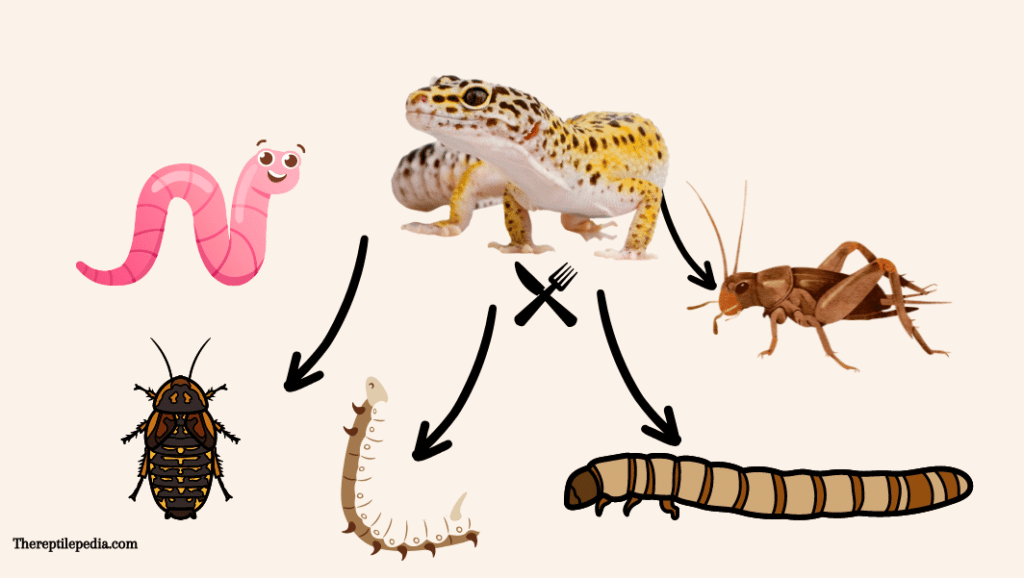
While superworms are occasionally a safe option to feed, there are staple feeders and insects that are better choices for your gecko’s diet. At the top of the list of feeder insects for a gecko are Crickets, Dubia roaches, Phoenix worms, Mealworms, Silkworms, and Hornworms. These insects are moderately high in moisture and protein but reasonably low in fat, making them more recommended for regular feeding. You can sometimes feed these insects to provide the finest nutrition, with any two of these making the mainstay selections in a well-balanced leopard gecko diet.
What’s Better – Superworms or Mealworms?
In the history of reptile keeping, mealworms have sometimes gotten a bad rap, considered low-protein, high-fat, and barely digestible. This view of them as a non-nutritious food source is similar to that of super worms, often left out of the discussion. The truth, however, is not so bad. For reptiles, a variety of food is important, and this article aims to provide a comparative analysis of the difference, which is quite significant.
The distinctions between the two are notable. Mealworms have a thinner exoskeleton, making them easier to digest than superworms, with their thicker exoskeleton. Superworms, often left out in favor of mealworms, have a higher mineral content and are 5 times larger when fully grown, making them meatier but leaner than the fattier mealworms. Superworms also boast more calcium (about 11% to mealworms’ 3%), more fiber, and less water. They are additionally rich in β-carotene, Vitamin A, Vitamin E, and omega-3 fatty acids.
Both contain a tiny amount of Vitamin D, but, notably, mealworms cannot be refrigerated, affecting their longevity. The inclusion of superworms in a gecko’s diet isn’t so bad when considering these benefits, especially when this article highlights their nutritional value.
Is It Easier To Keep Superworms or Mealworms?
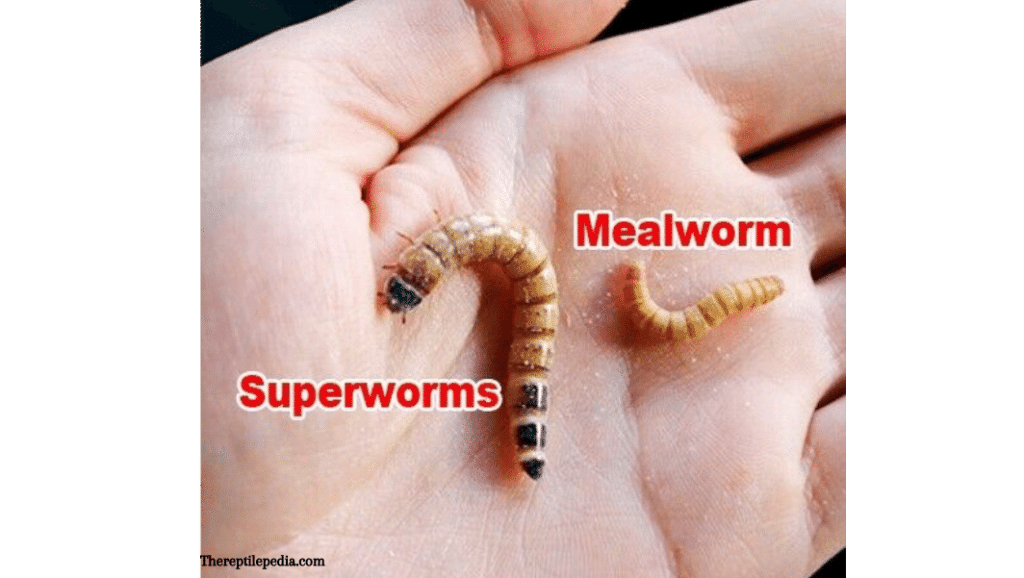
From my experience, keeping mealworms is generally easier. They can breed with no intervention, and their feeding, cleaning, and changing bedding are straightforward, maintaining a healthy colony that can replenish itself. A part of their colony lifecycle is fast at high temperatures, especially in summer. You can even refrigerate a part of the colony to slow down their development.
Superworms, on the other hand, are also easy to maintain. Their larvae require help to pupate into well-fed, mature worms. This involves separating them into boxes or containers with no food or water, as isolation triggers metamorphosis. This trait makes them less practical than mealworms, as their larval stage lasts a long time, requiring additional work and space.
Their superior appetites mean superworms will eat anything, making them easier to gut load. An important note for those in cooler climates is to watch them become extra pets, as their beetles are larger and more attractive. Unlike the often frantic mealworm beetles, superworm beetles are chill, slow-moving, and calmer, making them a friend rather than a nuisance. This demeanor can be likened to intelligent aliens – a funny but true observation about these fascinating creatures.
Can I Refrigerate Superworms?
Unlike mealworms, superworms cannot be refrigerated. Refrigerating super worms doesn’t prevent them from growing; instead, it can avoid the task of caring for them but with a potential downside – they will eventually die. Exposing superworms to low temperatures is not advisable for this reason.
The key to understanding this lies in the fact that superworms are not poorly adapted to cold temperatures because they are tropical insects that have not evolved to withstand such conditions. So, if you’re thinking about chilling your Superworms to slow down their growth, it’s a strategy that may not work well, and it’s better to explore other means of controlling their population.
ALSO READ: Can Leopard Geckos Eat Earthworms?
Conclusion
Leopard geckos are magnificent pets, and for pet owners, they are a true joy to watch and study. These amazing animals provide diverse diets for leopard geckos, contributing to their nutrition. One food they particularly enjoy is superworms, which can be a rewarding addition to a gecko’s diet in several ways.
Superworms offer fantastic benefits, especially when preparing for the arrival of hatchlings and young geckos. The majority of geckos find the flavor of superworms crispy and tasty, making them a delightful treat. These insects are an excellent addition to a leopard gecko’s diet when used in moderation. It’s a good idea to give your pet the pleasure of watching them enjoy superworms while taking care to avoid accidental injury.
Including superworms in your gecko’s diet can be essential for their health, provided it’s done in moderation. This article aims to highlight the benefits of this addition and offer guidance on how to provide the best care for your beloved pet.
FAQs:
-
What Kind of Worms Can Leopard Geckos Eat?
Leopard Geckos can eat a variety of worms and insects, including crickets, mealworms, silkworms, tomato hornworms, butterworms, beetles, sow bugs, and cockroaches. Waxworms and superworms should be fed sparingly, only as a treat, due to their high-fat content, to avoid obesity in the gecko. These treats should be provided no more than once a week.
-
Can superworms chew through the Stomach?
In the fascinating world of Leopard Gecko care, a common concern I’ve encountered is whether Superworms pose a threat to these reptiles. To clarify, most animals, including Leopard Geckos, instinctively kill or incapacitate the superworm by biting down on it. This natural behavior is crucial for safe feeding. In the rare instance, that a superworm isn’t dead initially, there’s no cause for alarm. The animal’s stomach acids are more than capable of handling the situation. It’s a myth that a Superworm could wake up and chew through the stomach or cause any internal harm. Rest assured, when fed responsibly, superworms can be a nutritious part of a Leopard Gecko’s diet.

